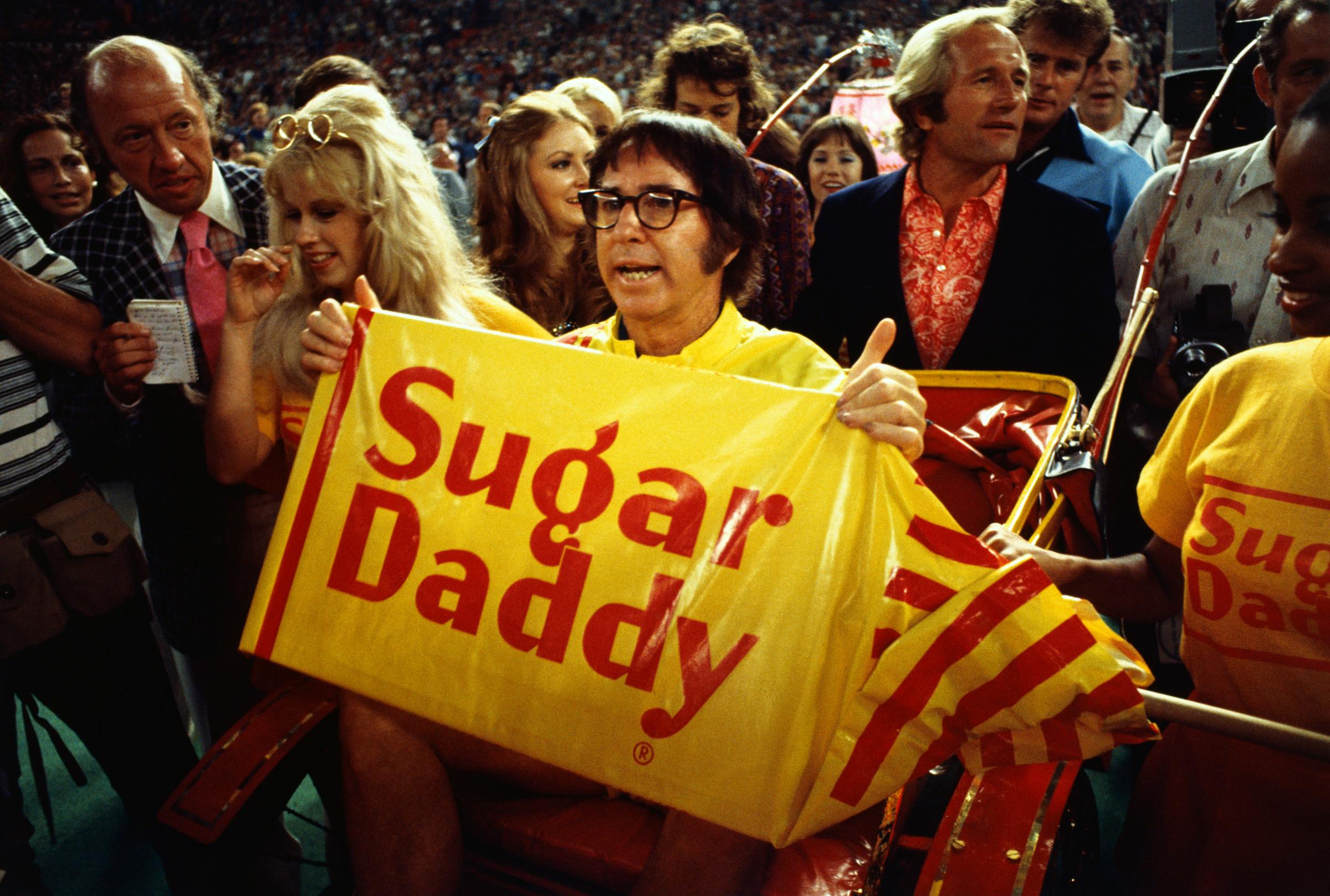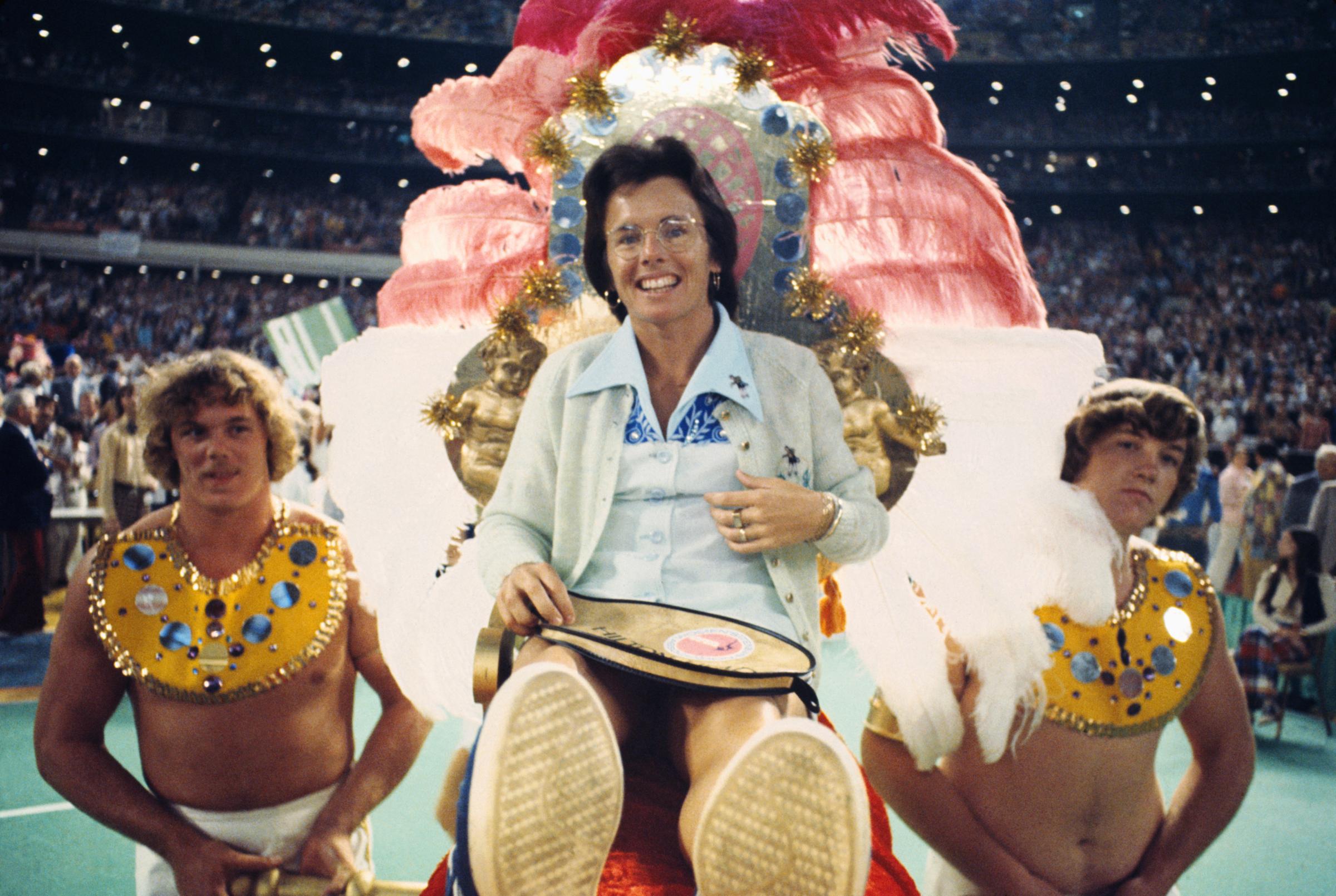The 1973 tennis match between Billie Jean King and Bobby Riggs was a spectacle made for Hollywood. King was at the top of her game, the first female player to win over $100,000 in a year. Riggs was an over-the-hill showboat and self-declared chauvinist pig with a gambling problem. Riggs hoped for one last minute of fame, King to prove that women deserved as much prize money and respect as men.
Ninety million people tuned into “The Battle of the Sexes,” and 44 years later Emma Stone and Steve Carrell are bringing the match to the big screen. The movie details both the on-court drama and the behind-the-scenes turmoil affecting the two tennis legends. The married King had recently begun an affair with a woman, while Riggs was struggling to connect with his family. Here’s what the movie got right about the historic game that made King an icon — and what the filmmakers exaggerated.
Fact: Billie Jean King came into conflict with Jack Kramer
Once a tennis champ himself, Kramer (Bill Pullman) was running the Pacific Southwest Tennis Tournament in 1970. That tournament offered women just 15% of the prize money that it awarded the men, despite that the women’s final sold as many tickets as the men’s final did. King challenged Kramer about the pay gap, and when he would not agree to up the women’s prize money, King led a walk-out. She and several other women went on to create the Virginia Slims tour and later the Women’s Tennis Association.
Kramer and King came into conflict again three years later on the eve of the Battle of the Sexes game. Kramer was set to be a commentator for the game, and King threatened to call off the match at the last minute if Kramer wasn’t removed. She argued that he was biased against female tennis players. The network conceded to her demands.
Fact: Virginia Slims sponsored that women’s tennis tour
In retrospect, the cigarette company was probably not the best sponsor of an athletic tournament. But it was the only advertising money they could get. Sarah Silverman’s character, Gladys Heldman, did indeed arrange the Virginia Slims tour. She asked the players to sign symbolic $1 contracts before they had enough money to pay the players and then wrangled sponsors. The women were suspended by the USTA but when the women’s tour proved successful, the two tours merged again.
Once a tennis player herself, Heldman founded World Tennis magazine and supported female tennis players in their support for equal pay. Her own daughter, Julie, even joined the separate women’s tour.
Fact: Riggs played poker with his therapist
He was, truly, a hustler.
Fiction: King and Riggs were old friends
In the movie, the two tennis players seem to know each other well — not only does Riggs call King in the middle of the night to challenge her to a match, but King dismisses the call as typical Riggs behavior. In reality, King says she barely knew the former champion, who was 25 years her senior.
However, after the Battle of the Sexes the two became friends and remained close until his death in 1995. King said she spoke to Riggs the day before he died, and they said “I love you” to each other.
Fact: King did initially turn Riggs down for the match
And he did then ask Margaret Court (Jessica McNamee) to play him instead. Riggs defeated Court in the “Mother’s Day Massacre,” which changed King’s mind about playing Riggs.
King and Court really were rivals, their careers intertwined. King’s first major singles success came in 1972 when she upset the top-seeded Court in the second round of Wimbledon. For the next decade, they competed for the top spot of the women’s rankings. Over the course of their careers, Court won 24 majors, and King just 12. That made King’s ability to defeat Riggs after the Mother’s Day Massacre extra sweet.
Fact: Margaret Court is opposed to same-sex marriage
The conservative tennis player has publicly called same-sex relationships “a lust for the flesh.”
Fact: During the “Battle of the Sexes,” Billie Jean King was involved with her hairdresser
The affair really did take place in the period before the Battle of the Sexes. King’s relationship with hairdresser Marilyn Barnett later became public in 1981 when Barnett sued King for a share of the tennis player’s property. In the suit, Barnett argued that because she gave up her career as a hairdresser to become a secretary, confidante, cook “and all other things necessary so that Mrs. King’s energy could be totally directed toward playing tennis,” under California law Barnett was due palimony, according to the New York Times.
King, who was still married to Larry King (Austin Stowell in the movie) at the time, initially denied the affair. But later that year she called a press conference in which she admitted her involvement with Barnett (Andrew Riseborough). “People’s privacy is very important, but unfortunately someone didn’t respect that,” she told The Chicago Tribune. “I did have an affair with Marilyn, but it was over quite some time ago. I’m very disturbed and shocked that Marilyn would do this in such a selfish way.”
Billie Jean and Larry King divorced in 1987. King is now in a relationship with Ilana Kloss, also a former tennis player. She has since become a prominent booster for LGBTQ rights.
Fiction: Barnett showed up right before King’s match to give her a haircut
The scene in which Barnett runs out of her salon to find King and give her a confidence boost (and a haircut) right before her face-off with Riggs is Hollywood fabrication. The haircut did happen but in Los Angeles before King left for the match in Houston.
Fact: Riggs was sponsored by Sugar Daddy

Fact: Designer Ted Tinling did indeed design King’s dress for Battle of the Sexes
Alan Cumming’s character really did dress the female tennis players for the Virginia Slims Tennis Circuit. A former World War II spy and tennis player himself, Tinling became infamous in the tennis world when he was banned from Wimbledon because his outfits were “too racy,” according to Cumming.
Fact: Howard Cosell draped an arm around tennis star Rosie Casals during the match commentary
The condescending move was all-too-real and broadcast on live TV. The filmmakers edited actor Natalie Morales into the real footage.
Fact: King wore blue suede shoes
Her outfit is now on display at the Smithsonian.
Fact: Riggs was taking 415 vitamins a day before the match
Before the match with Margaret Court, the 55-year-old Riggs enlisted the help of Hollywood nutrition guru Rheo Blair. He began a protein and dairy-focused diet and popped hundreds of vitamins every day.
Fact: Larry Riggs did not attend the match
Selena Roberts writes in A Necessary Spectacle that Bobby Riggs’ son foresaw his father’s downfall when Bobby didn’t take his training seriously. In protest, he refused to attend the King-Riggs match.
Fact: Billie Jean King was carried like Cleopatra into the Astrodome

Fact: When King won, Riggs said, “I really underestimated you.”
King has shared the mid-court conversation, included in the movie, with reporters. Riggs reportedly later said after the match, “This is the worst thing in the world I’ve ever done.”
ESPN once reported that the entire match was rigged by the mob. King denies that this was true, and the directors say that those they spoke to close to Bobby thought the accusation “ridiculous.” The filmmakers probably show Riggs betting on himself to win in the film in order to debunk the rigging rumor.
Fiction: King cried alone in the locker room after winning
King says didn’t get a moment to herself after the historic match. “They kept me so busy after that, but that’s how I was feeling, such relief,” King told USA Today.
More Must-Reads from TIME
- Donald Trump Is TIME's 2024 Person of the Year
- Why We Chose Trump as Person of the Year
- Is Intermittent Fasting Good or Bad for You?
- The 100 Must-Read Books of 2024
- The 20 Best Christmas TV Episodes
- Column: If Optimism Feels Ridiculous Now, Try Hope
- The Future of Climate Action Is Trade Policy
- Merle Bombardieri Is Helping People Make the Baby Decision
Write to Eliana Dockterman at eliana.dockterman@time.com